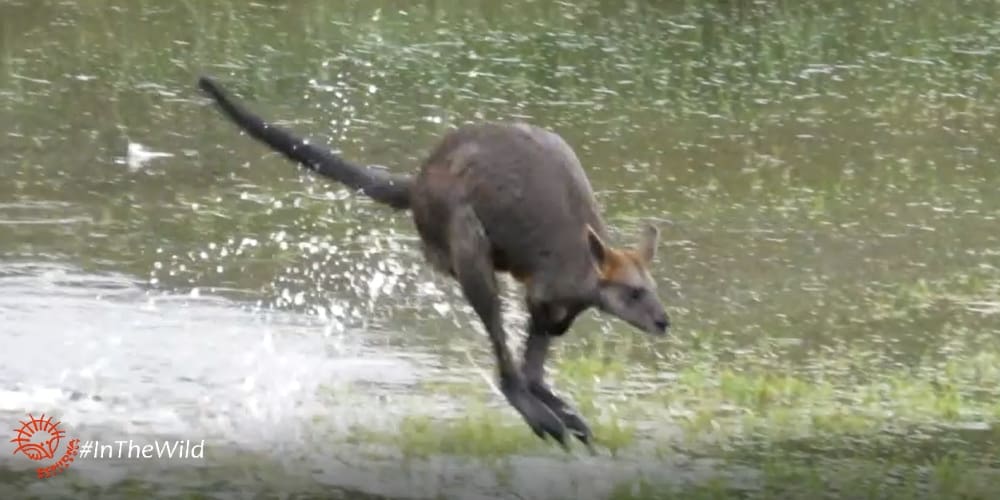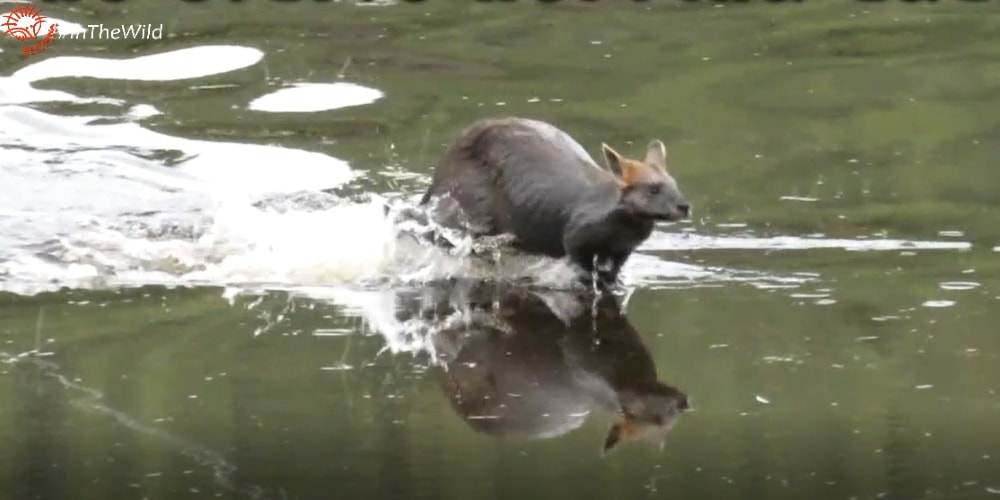Kangaroos and wallabies are land animals that hop – they are famous for it. So it comes as a bit of a surprise to find out that they can swim!

Wildlife Guide Brett and his Great Ocean Road group had stopped to look at a group of herons and spoonbills on one of our favourite quiet back roads. They looked out across the sodden floodplain to see a Swamp Wallaby hopping their way.
He was hopping straight for the river.

Without a word, Brett and guests all dived back into the car for their cameras.
The wallaby kept going – at full power he hit the shallow water. Splash, splash, splash… splonk.…

In the deep water the macropod stopped hopping and started swimming.
Wallabies and kangaroos swim quite well. But how?

They stop hopping, and start paddling. Automatically their back legs start to work independently of each other. One leg forward, one leg back. As we do when treading water.
On land they don’t do this. They can’t. Their back legs are designed to move in tandem.
In water, hopping probably doesn’t propel them forward. There is nothing to push off. So maybe they revert to an ancestral type of movement. Tree Kangaroos, relatives of wallabies that now live in trees, can ‘walk’ amongst tree branches, with their back legs moving independently. They can also hop when they’re on the ground. So the ability to move back legs separately has not been lost from the family.
More about our amazing Tree Kangaroos
Tree-Kangaroo and Mammal Group and TREAT are creating wildlife corridors under roads and re-planting habitat for tree kangaroos. They have some great information and beautiful pictures on their websites and facebook pages. Please support them: http://www.tree-kangaroo.net/ http://www.treat.net.au/index.html
Brett took this amazing video of the wallaby swimming along the Great Ocean Road:
If you watch closely you’ll see in the video the moment when hopping changes to swimming, and swimming changes to hopping again as soon as he hits solid ground. Watch the hips – when the wallaby is swimming his left side goes up while his right side goes down.
Research done in 1974 (Wilson – see below) photographed kangaroos swimming from underwater and they found something amazing.
Macropods pace when they swim. Their front leg and back leg on the same side move together. So as their left front leg goes forward, their left back leg goes forward. That is the opposite to how a dog paddles, or how a horse walks. The only other four-legged animals that do this naturally are camels, elephants, bear and giraffes.

Kangaroo swimming from underwater – from Wilson, George 1974 http://www.awt.com.au/wp-content/uploads/downloads/2012/08/swimming.pdf
The research also found that the main forward propulsion is provided by the front legs. The back legs mostly seem to keep the kangaroo upright. The tail lashes back and forth in rhythm with the swimming motion, providing further propulsion.
Brett and his Great Ocean Road guests were thrilled to watch this wallaby swimming, and even more thrilled to have captured it on camera.
Taking time to travel the Great Ocean Road always pays off with quality wildlife sightings like this one.
Want to learn more about kangaroos and wallabies? Read our 5 Kangaroo Joey Facts You’ve Never Heard Before!

….
LINKS:
Wilson, George R. 1974 “How Kangaroos Swim” unknown publication: http://www.awt.com.au/wp-content/uploads/downloads/2012/08/swimming.pdf
TREAT: http://www.treat.net.au/index.html
Tree-Kangaroo and Mammal Group: http://www.tree-kangaroo.net/

